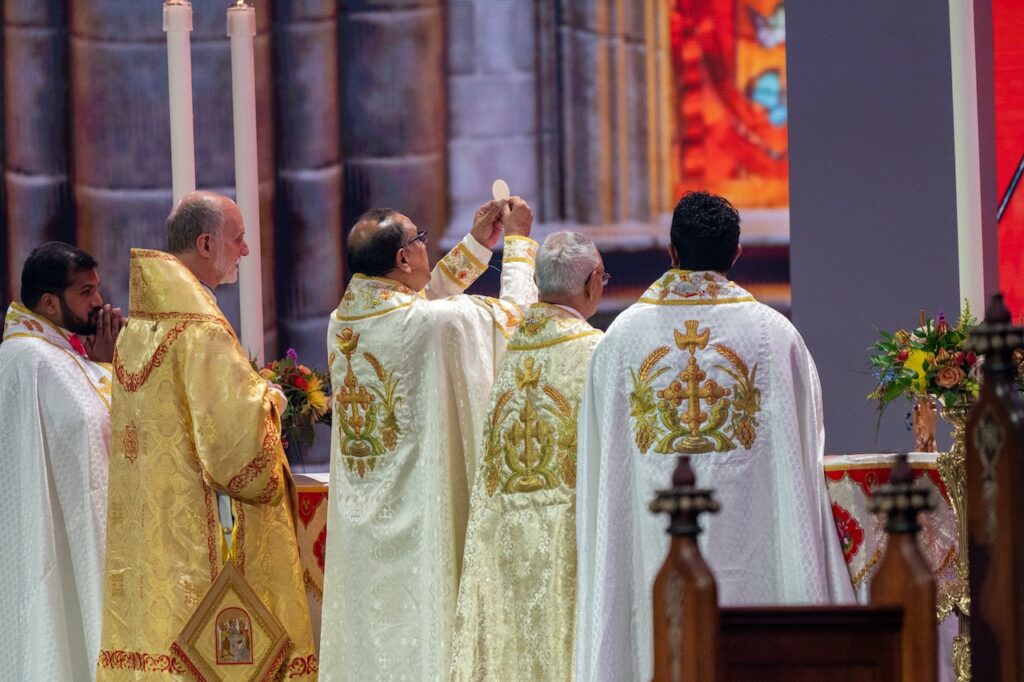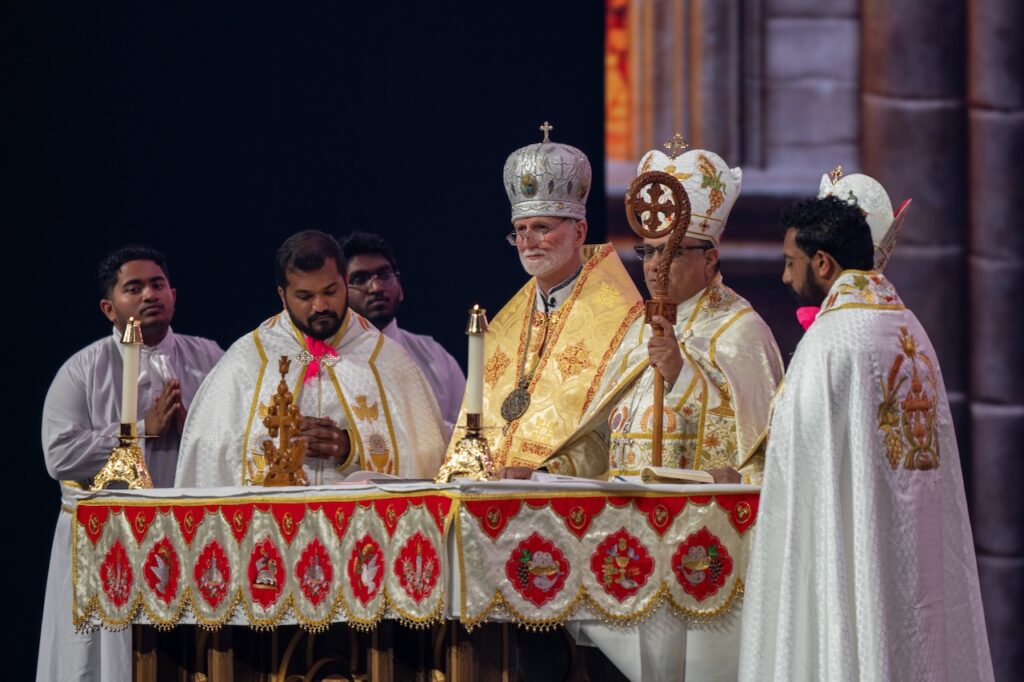(OSV News) – At the 10th National Eucharistic Congress, thousands of pilgrims experienced the “Eastern flavor” of Catholic liturgy.
The schedule for the congress included three Eastern Catholic liturgies – two Divine Liturgies in the Byzantine rite, celebrated July 18 by Bishop Bohdan J. Danylo of the Ukrainian Catholic St. Josaphat Eparchy of Parma, Ohio, and July 19 by Bishop Robert M. Pipta of the Byzantine Catholic Eparchy of Parma, Ohio; and a July 20 Syro-Malabar Holy Qurbana celebrated by Bishop Joy Alappatt of the St. Thomas Syro-Malabar Catholic Eparchy of Chicago, with Metropolitan Archbishop Borys A. Gudziak of the Ukrainian Catholic Archeparchy of Philadelphia as homilist and concelebrant.
The 23 Eastern Catholic churches with the Latin Church comprise the universal Catholic Church, through their shared communion with the pope, who, as bishop of Rome, is the head of the Latin Church. Eastern Catholics worship according to different liturgical forms that have a long and unique history in each Church.
Bishop Alappatt explained to the tens of thousands gathered at Lucas Oil Stadium for the July 20 Qurbana that the Syro-Malabar form of Catholic celebration of the Eucharist – which was in English with some hymns in the original Syriac language – “originated from the time of St. Thomas the Apostle … who came to India in A.D. 52, and because of his mission work we got a Catholic community in India.”
Of the Eastern Catholic churches, the Ukrainian Catholic Church is the largest. The Syro-Malabar Catholic Church, with 5 million members, almost 10,000 priests and more than 30,000 women religious, is thriving as well, said Archbishop Gudziak in his July 20 homily.
He described the Syro-Malabar Church as “amazing,” even as it is tested in India, where “Christians don’t have it easy.”
Catholics also face persecution under Russian occupation in Ukraine, said Archbishop Gudziak.
He described his recent meeting in Ukraine with Redemptorist Fathers Ivan Levitsky and Bohdan Geleta, who were released June 28 after some 18 months in Russian captivity, during which time they were “severely tortured.”
“These two priests reflect the suffering of the body of Christ,” said Archbishop Gudziak. “The Church carries the wounds of the war.”
From the “holy place of the cross flows the blood of the Eucharist,” said the archbishop. “This body of the Lord that has been hung between heaven and earth, that is sacrificed for your and my sins, is the body which feeds us today.”

That nourishment enables the faithful to evangelize the world, said Bishop Pipta at the July 19 Divine Liturgy, which he celebrated at St. Athanasius the Great Byzantine Church in Indianapolis.
“If we are intimately united with God and the Eucharist, we’re intimately united with one another,” he said in his homily. “We go forth (after the liturgy) in peace in the name of the Lord to live according to this intimacy with God.”
According to estimates obtained by OSV News, 2,500 people joined the Divine Liturgy July 18 with Bishop Bohdan, and about 500 filled the church to overflowing at St. Athanasius’ Divine Liturgy July 19 with Bishop Pipta. National Eucharistic Congress organizers told OSV News that an estimated 25,000 people joined the Qurbana celebrated July 20 in Lucas Oil Stadium.
Bishop Andrew H. Cozzens of Crookston, Minnesota, the board chair of the National Eucharistic Congress, Inc., told reporters that one of the congress’ themes was unity, which is why they featured the Catholic Church’s Syro-Malabar form of Eucharistic celebration so prominently among the congress liturgies.
“The Catholic Church is a universal Church. It speaks every language on earth. We’re the most diverse organization in the whole world, because every culture and every language celebrates the Eucharist differently,” he said.
The bishop said the prominent celebration of the Qurbana in the stadium “was really an emphasis on the unity of the Church and wanting our people to experience that beautiful diversity.”
He said, “It’s the same Jesus in the Blessed Sacrament but present in a very different liturgy.”
Read more about the National Eucharistic Congress.

